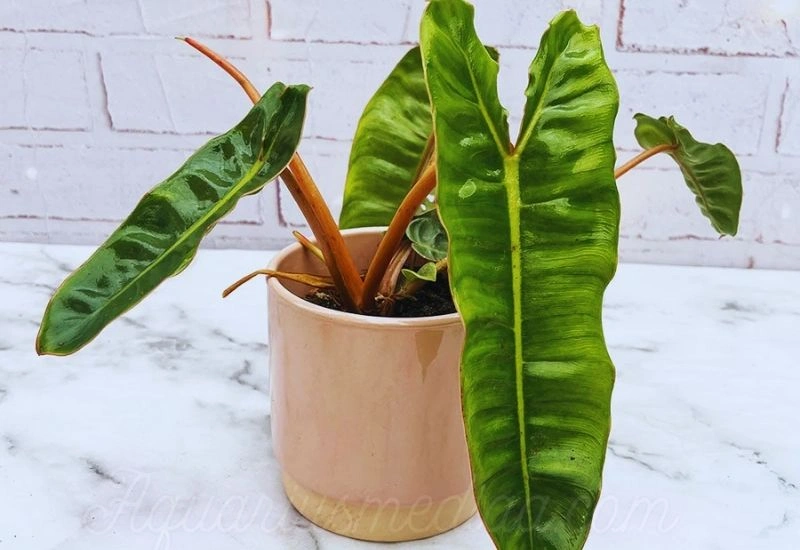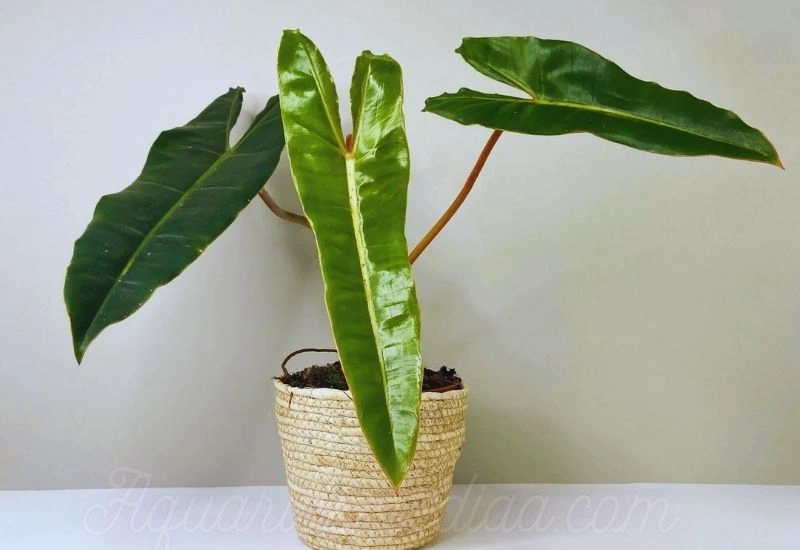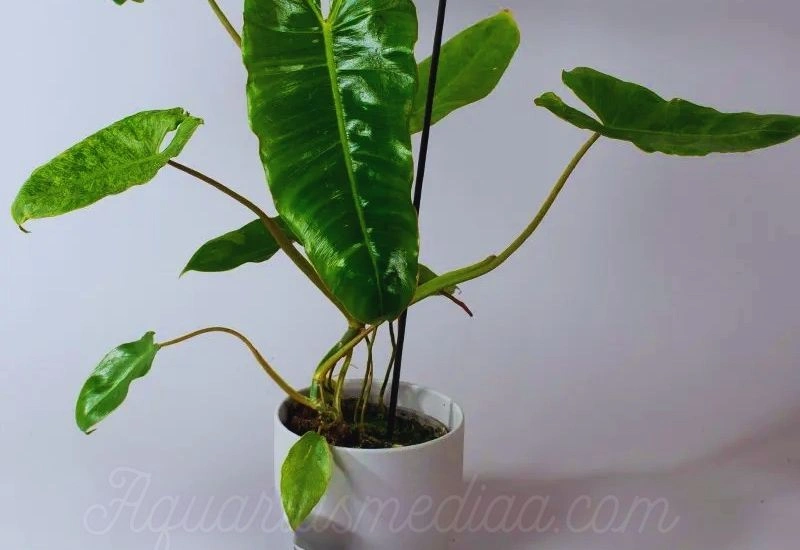In this blog post, you’re going to learn how to easily propagate and care for Philodendron billietiae.
This is a comprehensive guide covering reliable information about different aspects of this cultivated variety.
In this post, I’ll cover:
- Interesting Facts
- Propagation
- Repotting
- Care
And
- Solutions to Common Problems
So, if you are looking to propagate and care for Philodendron billietiae, this guide is for you.
Fun Facts
| Common Name | Philodendron Billietiae |
| Botanical Name | Philodendron billietiae |
| Family | Araceae |
| Plant Type | Perennial, vine |
| Fruit | Not prominent |
| Mature Size | 90 cm tall, 20 cm wide |
| Sun Exposure | Partial to low |
| Soil Type | Moist, fertile, organic, well-drained, well aerated |
| Soil pH | Acidic, neutral |
| Native Area | French Guiana, South America |
| Toxic | Cause irritation due to calcium oxalate |
| Growth | Slow |
Philodendron billietiae is a well-known climbing plant. You will recognize this plant through its heart-shaped leaves, with yellow-orange petioles. Their leaves will have a length of about three feet (91 cm).
Frieda Billiet discovered this plant in Brazil in 1981. It was found in warm, humid rainforests of French Guiana.
Benefits
- Philodendron billietiae is a natural air purifier. Even NASA is using this plant to remove formaldehyde, benzene, trichloroethylene, and xylene.
- Furthermore, you just need to provide them with 3 hours of direct sunlight, and then you can keep them in the shade.
- Its beautiful leaves can give smoothness and freshness to your eyes.
Propagation

This plant also propagates through its stem cuttings. Therefore, you can multiply your Philodendron through its stem cuttings. You can use water, sphagnum, or soil to propagate this plant. You just have to follow these simple steps, and you will be rewarded with a new plant.
- Firstly, cut a small piece of plant with a few nodes on it. You should use sterilized and sharp tools.
- Then, remove leaves from one side without damaging the nodes.
- Put the cut side in the water container. Ensure that no leaves touch the water, as they can rot. After two or three weeks, tiny roots will develop on the stem.
- Now, you can put that stem cutting in a loose soil mixture.
In this way, you can propagate this plant through its stem cuttings. To increase the growth rate, you can use a growth hormone. In the first few weeks, you have to avoid harsh conditions. But later, you can provide normal conditions.
Repotting
You have to change the pot after the first two years. The new pot should be 4 inches larger in diameter than the first one. Then, you have to prepare a soil mixture that fulfills all the plant’s needs.
In this method, you will put out the plant from the previous pot without damaging any of the parts. Then, trim all the damaged, rotted, or dead roots, leaves, and branches. Now, you have to hold the plant in the new container and pour the soil mixture around the plant. You can settle the soil in the container by spraying water. In this way, you can repot your plant in simple steps.
Care

To care for this Philodendron species, you have to replicate the conditions of its natural habitat. So, you have to maintain semi-shade, moderate water, and place it indoors.
Pruning
Pruning Philodendron billietiae doesn’t require any professional techniques. You just need a sharp and sterilized pair of scissors and a knife. Then, identify the spots to snip. You have to find the diseased, damaged, or dead leaves and branches. Then, cut them without damaging the nodes. In this way, you will prune the entire plant. Moreover, some people want to prune to shape the plant in a specific design.
Soil
In the case of soil, you have to maintain a balance between moisture and dryness. Moreover, there should be adequate nutrients for proper growth. Therefore, you will need a soil that is fertile, organic, well-drained, well-aerated, and loose. To make such soil, you have to mix the following constituents.
- Peat moss
- Perlite
- Compost
- Fertilizer
Pot
Like other Philodendrons, it will need a pot with proper well-drained holes. Moreover, their pot should have enough capacity to hold the roots comfortably. In the market, you will have a pot with 12 cm.
For repotting, you will need a 2 to 3-inch larger pot for this plant.
Water
Philodendron billietiae needs slightly more water than other Philodendrons. You need to keep the soil moist all the time. At the same time, you must avoid overwatering, which can result in water logging.
You can check whether the plant needs watering by touching the finger to the soil.
Light
Its native area is the rainforest, which has dense plantations. Thus, these plants receive shady sunlight. However, they can tolerate morning and evening sunlight. You should avoid keeping them in direct sunlight for a prolonged time, as it can scorch the sensitive leaves of this plant.
Ideally, it needs about eight hours of bright, indirect sunlight.
Fertilizer
For fertilizing, you have to keep in mind the following tips.
- Fertilizers must have nitrogen, phosphorous, and potassium.
- Fertilize your Philodendron only during the growing seasons, spring and summer.
- You should not fertilize your plant more than once in a month during spring and summer.
- Stop fertilizing your Philodendrons in dormant phases.
- Always use water-soluble fertilizers in dilute form.
- If you have done overfertilizing, you should immediately wash the soil with water.
Placement
This plant can survive in a medium amount of sunlight. Additionally, direct sunlight can burn its leaves. So, you should place your plant in a place with filtered sunlight. In the indoors, the best places are the east and north-facing windows with proper curtains. However, you can choose kitchens or washrooms if your plant needs high humidity.
Temperature and Humidity
You should maintain a temperature between 18 to 27 C. In this way, you are replicating the natural conditions of their native tropical regions.
Moreover, it needs high humidity that ranges between 60 to 80%. It will be similar to that of the rainforests to a great extent.
Common Problems

Pests
These plants are constantly exposed to pests. You need to check the leaves of this plant regularly. Pests suck the sap and increase their population rapidly. Therefore, whenever you observe any of the symptoms of the pests, treat them immediately. You can remove pests through different remedies, such as using insecticides or neem oil on the leaves of these plants.
Fungal Diseases
Fungi can develop rust spots in the form of reddish-brown dots. Remove these infected parts immediately without touching them. Dispose of that part to stop spreading this infection to healthy parts of the plant. Furthermore, you can use a fungicide to treat such issues.
Bacteria can also affect the Philodendron by developing a dark green spot on leaves that can result in the death of the leaves. These develop when you keep the leaves in water for a prolonged period.
Brown Tips
It is a common issue for Philodendron billietiae. The main causes of the leaves browning are low humidity levels and underwatering. Therefore, you can install a small humidifier near your plant to prevent such issues.
Curling Leaves
The leaves of the Philodendron curl due to over and under-watering, low humidity levels, over-fertilization, etc. You can treat this problem by balancing the conditions of the plant.
Yellow leaves
Yellowing of the leaves can occur due to several reasons.
- Green leaves can naturally turn yellow due to their age.
- Sometimes, high temperatures can cause yellowing of the leaves.
- Too much exposure to the sun can cause yellowing and wilting of the leaves.
- Some gardeners suggest that underwatering can yellow the leaves.
Treatment of this issue is relatively easy. You just need to work on regulating the appropriate conditions of your Philodendron.
Varieties & Similar Plants

Philodendron billietiae has leaves that are unique in shape. These are different from the leaves of other species of Philodendron. Only Philodendron Monstera’s leaves have a similar shape to some extent. Both have elongated leaves of large size. The only difference is the splits in the leaves. Monstera has long splits in their leaves, while Billietiae doesn’t.
Ready to Grab a Philodendron billietiae to add beauty to your home garden?
All the above information is reliable, and you’ll see outstanding results if you want to grow or care for this plant.
